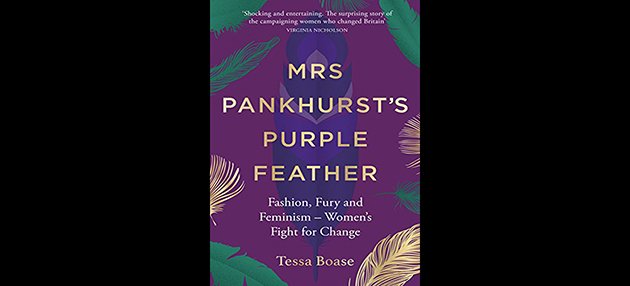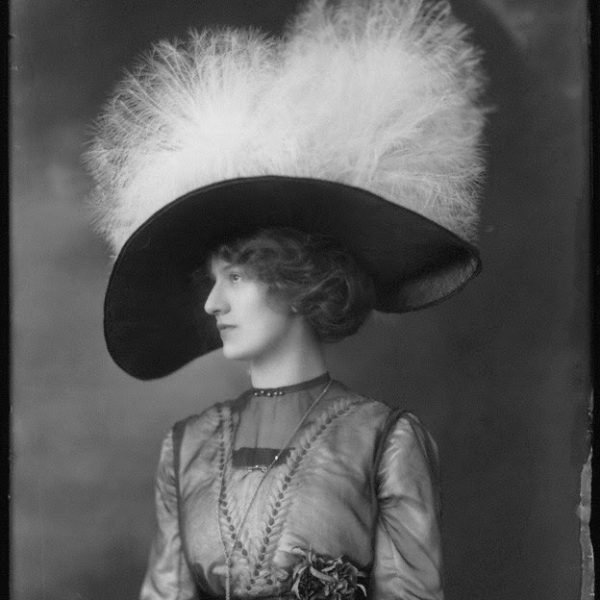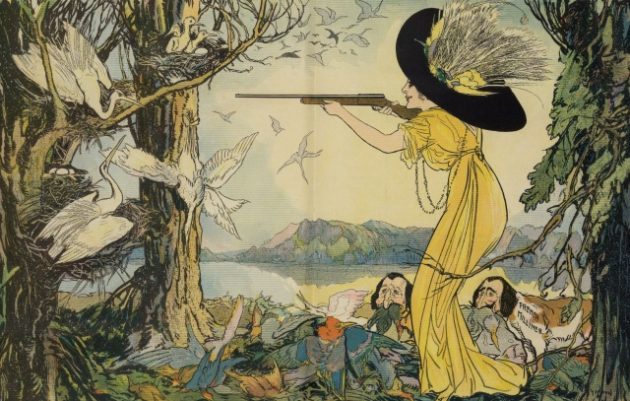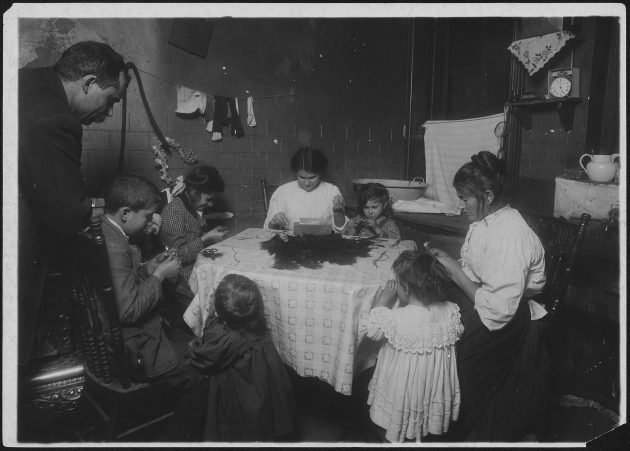
A feather is a magical thing. There is a wonder to its construction and color, a mystery that goes beyond what we know anatomically about how feathers function. And, like many body parts that are separated from the whole, a feather sometimes become an artifact, a thing apart from a living creature, invested with values beyond the original, biological function. Last year I reviewed The Feather Thief, an enjoyable tale centering on the use of feathers in the Victorian art of salmon fly-tying, and how that led to the theft of priceless bird skins by one obsessed young man. Mrs Pankhurst’s Purple Feather: Fashion, Fury and Feminism – Women’s Fight for Change by Tessa Boase, published shortly after The Feather Thief (pure coincidence, but an interesting one), focuses on a different role—the appropriation of the feather–actually, thousands, maybe millions of feathers– for fashion. Women’s hats, specifically, a significant sartorial symbol of class and status in the late 19th and early 20th centuries. And the book is about much more, ripple effects from what happens when part of a living thing becomes the central ingredient to a highly visual, social, profitable business.
The late Victorian age was not a good time to be an egret! Their populations, plus those of other species that ‘wore’ the coveted long, colorful feathers used for women’s fashionable hats, were being dangerously depleted by hunters intent on feeding the millinery industry. The illustration above, reprinted in Mrs Pankhurst’s Purple Feather, shows what was apparently a typical adornment, the “osprey,” egret feathers that had been cleaned, combed, twisted, and puffed. More examples, shown in the book and online (just search for ‘hats’ and ‘egrets’ and you’ll find articles from NPR, the Smithsonian, and Audubon), show delicate to huge creations adorned, sometimes overwhelmed with plumes, colorful teased feathers, and even the actual bodies of birds.
This mass avian exploitation, amazing and repugnant, ultimately met its end through separate campaigns in the United States and Great Britain, each led by women, mostly upper-middle class women. Fitting, since New York City and London were the centers of the millinery trade. Both campaigns led to the establishment of national, influential conservation organizations–National Audubon Society in the U.S. and RSPB (Royal Society for the Protection of Birds) in Great Britain–and the establishment of strong legislation banning the use of nesting and migratory birds for industry and protecting these birds from other types of slaughter (the Lacey Act of 1900, the Weeks-McLean Act of 1913, and ultimately the Migratory Bird Treaty Act of 1918 in the U.S. and the Importation of Plumage (Prohibition) Act of 1921 in Great Britain).
Boase looks at this period through the lens of British female activism. The title Mrs Pankhurst’s Purple Feather encapsulates the two main topics of her social history: (1) the lengthy struggle by the four women founders of the Society for the Preservation of Birds (the organization didn’t receive the Royal charter till 1904) to stop bird-killing-for-millinary practices, and (2) the militant suffragette movement led by Emmeline Pankhurst and her daughters. This might seem a little strange, but Boase succeeds in finding parallels and ironies in these two roughly chronological movements (the bird campaign began earlier, but both sociopolitical struggles were moving in full force by the early 20th century). Both were led by strong, intelligent women who needed to develop new ways of making their points with the public and the government; both movements were lynchpins in developing today’s values of human rights and environmental conservation. Ironically, only the women of one of these campaigns, the suffragette movement, have been recognized and honored. Part of Boase’s mission here is to piece together the lives and careers of the four women who founded the RSPB, now one of Great Britain’s most powerful and richest nonprofit organizations: Emily Williamson, Eliza Phillips, Winifred, Duchess of Portland, and Boase’s favorite, Etta Lemon.
This is where Boase excels. She has done an extraordinary amount of research in unearthing the early beginnings and activist lives of these women, and though these efforts aren’t always obvious in the book itself, you get a sense of how many archives she searched through to the dustiest corner, how many museum collections she examined, and how many people she interviewed by reading the book notes and, if you have the opportunity, attending one of the talks Boase has been giving in the United States and Great Britain.
As a librarian and women’s studies scholar, I greatly appreciate the research. I did often wonder while reading the book whether the result equaled the effort. These were admirable women, but their activism was rooted in a religious, missionary-type intensity rather than in observation of and knowledge of birds. This was not unusual for the time, but I found it made it harder for me, personally, to relate to these women, become invested in their history. Here I was, looking for “foremothers,” role models for how to be leaders in the birding world, and finding instead missionaries. This is particularly true of Etta Lemon, who Boase describes as THE driving force behind SPB activities for over 50 years. A resolute woman known as ‘The Dragon,’ Etta worked for many years behind the scenes with her husband Frank; once the Society became ‘Royal,’ she lost her title of Honorary Secretary because women were not allowed to hold office. (Her husband took on the title till his death, when Etta was allowed to hold it again.) Etta was also a leading member of the Women’s Anti-Suffrage League. She did not believe women needed enfranchisement.
The ironies and parallels between the suffragettes and the bird protectors become interesting at this point. The Women’s Social and Political Union (WSPU) leaders urged followers to dress well, echoing the style of their charismatic leader, Emmeline Pankhurst. Preferably, they should be wearing colors of purple, white, and gold, the branded hues of their movement. The purple feather of the title is an ostrich plume (now housed in the Museum of London), a symbol of Emmeline’s crusade and personal style (if you saw the 2015 film Suffragette, Meryl Streep, playing Pankhurst, is wearing a hat full purple feathers). The Pankhursts and their organization were not interested in saving birds; they saw the SPB mission as a distraction. The two organizations, both focused on what we today see as complementary missions, were fiercely working at cross-purposes.
This photograph of a family working on feathers while the father looks on is from the National Child Labor Committee Photograph series taken by Lewis Hine. It is reproduced in “Mrs. Pankhurst’s Purple Feather” in a slightly different format (no creases or tears) and with a credit for the Granger Historical Picture Archive, not Lewis Hine, though the photo is in the public record and not copyrighted.
There is a third story element that comes into play here, one that I found fascinating –the up-to-now largely invisible role played by the working-class women who prepared the feathers and made the hats. The book begins (after an excellent Prologue), not with young Etta making lists of women in her church who wore hats with feathers, nor with young Emmeline studying in Paris, but with the story of Alice Battershall, a 23-year old feather washer. In 1885, Alice was charged with the crime of stealing two ostrich feathers from her employer; she was punished with a sentence of three weeks hard labor in prison. Boase uses Alice’s story as the entryway into the global feather industry, built on the labor of women engaged in occupations with names like feather washer, purifier, dyer, beater, curler, willower, and shaper. She recreates Alice’s world, describing the poverty in which she and her co-workers, including children, lived, utilizing reports of government Factory and Workshop inspectors and, on the U.S. side, the writings of New York City reformer Mary Van Kleeck. This is good stuff. Any student of working-class history is familiar with the horrors of the sweatshop, but this is the first time I’ve seen it connected to our history of bird conservation. It gives us a much larger historical context. It also underlines the fact that, as Boase points out, thousands of feather industry workers lost their livelihoods once their use for millinery was prohibited.
So, we have here three historical stories about women–the founding women of the RSPB, the feather-wearing women of the suffragette movement, and the working-class women who made the hats. Add companion stories: the auctions in which feathers and avian body parts were sold in the thousands; the female proprietors of London’s most popular millinery stores; a controversial essay by Virginia Woolf on the Plumage Bill; the activities of the society women who wore the hats decorated with birds; the roles of Queen Alexandria, and Nancy, Lady Astor, first woman to take a seat in the House of Commons. And once in a while, there is a check-in on what was happening in the United States–the killing of a bird protection warden in the Everglades, investigations into millinery sweatshops, the earlier passage of bird protection legislation.
“The Woman Behind the Gun,” a commentary by artist Gordon Ross on fashion’s responsibility for the decimation of the egret population. The illustration appeared in “Puck,” a popular American magazine on May 24, 1911, and is now part of the Library of Congress Prints and Photographs Division. It is reprinted in the book, though without artist credit or date.
This is a lot of ground to cover, and Boase at times seems to be struggling. Mrs Pankhurst’s Purple Feather is organized into five parts–Feathers, Birds, Hats, Votes, Power–but sometimes I thought that Boase, who writes in a very personal style, let her enthusiasm for a particular topic interfere with her discipline as a social historian. Tales of Winifred, Duchess of Portland (and president of the RSPB from 1891 to 1954), and other titled women–their shooting parties, shopping expeditions, ball costumes–feel suffocating, though they will probably appeal to fans of Downton Abbey.
Boase admits to this partiality as she recounts the story of one particular milliner, Countess Fabbricotti, whose plebian background and shop business details she has astutely unearthed through diligent records research: “I admit to falling under the Countess’s spell as I flicked through those order books with their roll call of titles. I was seduced by her customers–their wealth, beauty, scandals, lovers and connections. I was seduced by her hats….” (p. 146). In contrast, she comments repeatedly on her difficulty in liking the main subject of her book, Etta Lemon, because of both her difficult personality and her anti-feminist stance. Boase clearly respects Lemon and holds to her goal of resurrecting her work and accomplishments in the last chapter, recounting in dramatic form the 1939 “coup” by male ornithologists, a “vicious vendetta” that led to a change in RSBP goals (more research-based projects–Lemon hated banding), Lemon’s ouster, and her absence from British ornithological and conservational history until the publication of this book.
I found certain characteristics of Boase’s writing style problematic. Curiously, though she writes from the viewpoint of a feminist, her prose often takes on a gender stereotypical tone. Many of the strong women of the RSPB are characterized as “masculine”: “There was something masculine about Mrs. Phillips at full throttle….” (p. 60); “Winifred Portland did not shoot, but she had a certain masculine quality, too” (p. 98); “The paintings of Pankhurst and Lemon seem to capture the defining difference between the two women: one is overtly feminine, the other rather masculine.” (p.265). I think that at this point in time, we are beyond using the terms ‘feminine’ and ‘masculine’ in ways that encapsulate traditional gender stereotypes. It’s much more precise to use the adjectives these words once conveyed, such as pretty (‘feminine’) and strong or resolute or courageous (‘masculine’).
Stereotypes are used again, in a different way, in the section on the feather industry. Again and again, Boase describes feather manufacturers–the men responsible for the labor sweatshops–as Jews. The very first page introduces Alice Battershall’s accusatory employer as “Abraham Botibol, a prominent Jewish feather manufacturer….” A few pages later, he is described as “a hard-nosed man of commerce—a London-born, middle-aged Sephardi Jew with heavy interests in the trade and prone to exploit his largely female workforce” (p. 3). He is never merely Mr. Botibol, he is always “Jewish manufacturer Mr. Botibol” (p. 5). The feather industry was “a known network of mostly Jewish employers between which the workers passed, were dropped and picked up again” (p. 4). No other characters or group of characters are described so persistently with the use of their religious, ethnic, or racial names. There is no effort at context. For example, while it is true that most of the feather manufacturers were Jewish, there were reasons, and these reasons are explained in a scholarly book cited heavily (for other facts) by Boase herself. Without these explanations, the continued use of ‘Jewish’ as a descriptor sends a very different message, one redolent of Shylockian stereotypes.
Another issue is Boase’s tendency to create stories, even when there is no factual evidence. This first came to my attention in her description of an 1888 feather and bird auction in London. Boase dramatically describes an undercover operation, a writer for The Auk, the American ornithological journal, paying “a clandestine visit” to the auction and evaluating the numbers and diversity of the thousands of skins and feathers for sale. She describes the reporter’s experience: “The deeper he walked into the warehouse, the brighter became the colours….The atmosphere in the warehouse was one of muted frenzy, as dealers sorted through bales of feather skins searching eagerly for novelties” and his thoughts: “Probably family Coerebidae, he noted, fleetingly imagining the live bird in its tropical habitat–the slender, curved bill; the flash of yellow belly; the shaggy round nest with a side entrance hole” (p. 51-52). The only problem is, none of this drama is in the original article, which is simply a listing of the items for sale as taken from the auction catalog. The undercover operation, the warehouse frenzy, the reporter’s thoughts–these were all manufactured by Boase.
The tendency to dramatize, to insert dialog and create scenes for which there are no factual basis occurs again and again throughout the book, particularly with Etta Lemon. Boase recreates Etta Lemon’s tea parties, complete with dialog; tells us Etta’s thoughts at RSPB meetings; and gives us a sample day of Etta running Redhill War Hospital during World War I, pushing “though the heavy front door”…”hit by the tarry smell of carbolic lotion”….nodding, tutting sympathetically as she is briefed by her head nurse (pp. 247-8). She describes Virginia and Leonard Woolf walking to the polling booth to vote in December 1918, Virginia noting the displays in the Surrey shop windows and commenting, “I don’t feel much more important” (p. 254). Only–Virginia Woolf was not in Surrey on December 14th, 1918. She was in Guildford visiting her dear friend Roger Fry, and her quote comes from the January 11th 2018 Diary entry, a brief one commenting on the passing of the Suffrage Bill by the House of Lords. I know, because I have Volume One of The Diary of Virginia Woolf on my bookshelf.
Although Boase sometimes makes clear that she is imagining her stories, filling out sparse facts with a play-like scene, there are too many other instances like the bird auction, when fiction is passed off as fact. This made me doubt parts of the book, particularly those that are uncredited or credited to a secondary source (both the auction and the Virginia Woolf story are from secondary sources, even though the originals are not difficult to find). For example, did Alice Battershall, the London feather washer who stole a feather, really marry a carter named Robert Chipchase, have a daughter and son, the latter lost to the war, and did she really walk to her polling booth in St. Luke’s Finsbury? First Boase tells us she did, then she says maybe she didn’t. There are times when it’s not clear if this is social history or a story based on the facts, like a television dramatization.
Mrs Pankhurst’s Purple Feather: Fashion, Fury and Feminism – Women’s Fight for Change by Tessa Boase is a unique piece of popular social history based on extensive research but undermined by a writing style that is less than historically rigorous. It ties together pieces of a very large tapestry encompassing women’s rights, bird conservation, the fashion industry, and what it was like to work in the millinery industry during the late 19th and early 20th centuries, a time before labor unions led the fight for safe workplaces and decent hours. Big personalities are at its forefront, some well known, others re-discovered by the author. The book doesn’t always succeed in its goals. But it contains many remarkable features, particularly its attention to invisible women–both the leaders of the bird protection movement in Great Britain and the working ‘girls’ who toiled in feather occupations that are now extinct.
Is this a book for American birders? That question haunted me as I read it, and I wonder if I can make a neutral recommendation, coming from a personal background that includes a master’s degree in women’s studies and work as a labor educator. For me, this book hit a lot of checkmarks, a lot of interests. It was fascinating to see the interconnections. And, irritating when the drama was valued above historical fact. Americans birders not familiar with our ornithological history will find the sections on feather exploitation and the global feather industry fascinating, though that is a relatively small part of the total book and most of that history can be read in other sources. This is really a book for British birders and Anglophiles. American birders will need to wait for our own book about how our women fought for birds and for the vote. Hopefully, there are leadership lessons there on how to deal with renewed threats and attacks on the Migratory Bird Act.
Mrs Pankhurst’s Purple Feather: Fashion, Fury and Feminism — Women’s Fight for Change by Tessa Boase
Aurum Press, June 2018, 336 pp.
ISBN-10: 1781316546; ISBN-13: 978-1781316542
Hardcover: $28 (less from the usual suspects); Kindle: $11.87














Leave a Comment